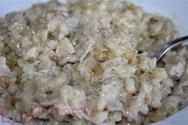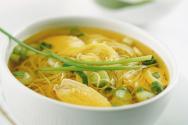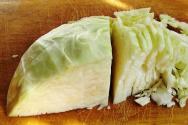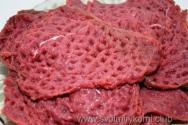Pesto sauce. Homemade recipes. Classic sauce and delicious variations. Pesto sauce - a recipe for making it at home, what to eat it with and what to serve it with. What “gadgets” to use for making pesto
Pesto is a world-famous Italian sauce with a bright, unusual and refreshing taste. Motherland traditional sauce– Genoa, Liguria region, located in northern Italy. From Italian, “pesto” means “to grind”, since all the ingredients included in classic recipe subjected to thorough grinding in a marble mortar. The main advantage of the aromatic sauce is that it does not require heat treatment. How to prepare pesto according to a traditional Italian recipe and what are the subtleties of its preparation - in our article.
Subtleties of preparing classic pesto
Pesto sauce harmonizes well with many dishes: it perfectly complements the taste of hot pasta, spaghetti, adds piquancy to meat, fish, shrimp, grilled vegetables, and is used to dress pasta salads. In Italy, pesto is so popular that Italians spread it on sandwiches.

The base of the pesto sauce is fresh basil.
To prepare the Italian classic sauce, you will need available ingredients. Pesto base: fragrant basil, hard cheese(the original uses parmesan) and good olive oil.
Additional ingredients, such as nuts and garlic, complement the dressing, perfectly highlighting its taste. To prepare aromatic green dressing at home according to the classic recipe, you must follow some cooking rules:
- basil and garlic should be fresh, not dried;
- if you don’t have the time or desire to grind the basil in a mortar, then you can use kitchen aids to grind it: a blender or food processor. Just don't overdo it and don't grind the basil very finely;
- If you use the classic method of preparing pesto - grinding it in a mortar, then do not use a wooden mortar so as not to muffle the delicate aroma of the greens.
Important! To prepare the classic sauce, basil with green leaves is used, which has a slightly bitter taste.
Classic pesto sauce recipe
To prepare the sauce, prepare the following ingredients:
- fresh green basil (bunch);
- 100 g Parmesan cheese;
- 150 ml olive oil;
- approximately 80 g pine nuts;
- 2-3 cloves of fresh garlic;
- a pinch of salt (coarse, preferably sea salt).

Cooking steps:
- Wash fresh green basil well and dry with a napkin. Sprinkle it with coarse salt and grind it thoroughly with a pestle and mortar.
- Fry the nuts in a frying pan, grind in a blender and add to the basil ground in a mortar, continuing to grind the green mass.
- Add finely chopped garlic cloves to the nuts and basil and continue grinding.
- Grate the cheese on a fine grater and place it in a mortar, mixing all the ingredients well.
- Add olive oil to the sauce; it must be poured in carefully, in a thin stream, stirring.
- The final stage of preparing pesto is to transfer the finished sauce into a container, seal it tightly and put it in the refrigerator to thicken.
The indicated quantity of products is approximate, be guided by your taste and sensations.

The finished pesto sauce looks very appetizing and attractive: bright green in color, thick and uniform consistency. Stores in the refrigerator for up to 7 days. For housewives who do not have the time and energy to thoroughly grind food, a blender will be an excellent helper. It is enough to chop the greens, nuts, garlic with a knife, place the sauce ingredients in a blender, add olive oil and beat the green mass for several minutes. Pesto instant cooking ready at home.
Advice! Pesto can be made in advance and frozen in an ice tray, divided into small portions. When preparing sauce for freezing, do not add cheese. It is better to add grated cheese before eating.
What products can replace the ingredients?
Pesto sauce is universal and you can prepare it using other ingredients that do not spoil it at all, but only change it slightly classic taste. Use the products you have on hand, don't be afraid to experiment and you'll get an equally great taste. homemade sauce pesto.

For example, instead of basil, you can use arugula, spinach, parsley, and cilantro. Walnuts, cashews, pistachios and even sunflower seeds are great substitutes pine nuts. Any cheese will work in place of Parmesan cheese durum varieties. To obtain a soft, delicate taste of the sauce, some housewives replace garlic with orange or lemon zest.
Bright, fresh and slightly spicy pesto is a wonderful vitamin-rich dressing for meat and fish dishes. There is a huge amount various options its preparations. Thanks to its rich composition, pesto is healthy and has high calorie content. You can prepare it at home very quickly, and unique taste, aroma and color can decorate any table.
Making pesto sauce - video
Pesto sauce - photo










This flavorful sauce– classic Italian cuisine. Its traditional version is made from basil and pine nuts. But the list of components can be changed depending on preferences. And there is absolutely no need to buy pesto sauce - make it at home without any problems. Whether prepared or homemade, pesto makes a great addition to pasta, fish, poultry, salads and sandwiches.
Ingredients
- 100 ml extra virgin olive oil
- 2 cloves garlic
- 50 g basil leaves
- 70 g shelled pine nuts
- 70 g Parmesan cheese
- 0.5 tsp salt
Preparation
Big photos Small photos
A little history
Pesto, like many other Mediterranean delicacies, boasts a long tradition. Probably, a paste made from crushed cheese, garlic, olive oil and herbs was eaten already in ancient times. Over time, basil became its main component. The tradition of preparing delicacies based on this plant has become widespread, in particular, in the Italian province of Liguria. Thanks to its capital, Genoa, the most popular variety of pesto became known as Genovese. It is assumed that sailors leaving the local port took a lot of basil paste on board, which during long sea expeditions allowed them to protect themselves from diseases, in particular scurvy. Around 1863, a famous cookbook about the culinary traditions of Liguria was published in Genoa. Its author, Giovanni Battista Ratto, posted this recipe for pesto. You need to take 3-4 cloves of garlic, basil, and if there is none, marjoram and parsley, Dutch cheese and also Parmesan, grind it all and mix until smooth. Combine it with oil and stir well. This is how the recipe sounded then, and it is still relevant today.
They say that the roots of pesto sauce go back to ancient times, that pesto is perhaps the “oldest” of the historically known sauces. Its homeland is Persia, from where pesto was brought to Italy, where it “established” its classical technology and variations. They also say that the sauce has existed in its present form for several centuries, that it is quite “conservative” and does not allow improvisation. For example, Italian chefs insist on pounding ingredients in a mortar - this is a tradition.

Valuable composition of pesto
Pesto is not only a tasty, but also a healthy dish, especially if you prepare it at home from natural products.
Basil. Basil deserves special mention. Behind medicinal properties this plant is responsible essential oils, for example, eugenol, the active particles of which have a strong anti-inflammatory effect. The plant is also a treasure trove of valuable tannins and flavonoids. It regulates the functioning of the digestive system, improves digestion, and facilitates the absorption of nutrients from food. Basil activates metabolism and has a good effect on the nervous system.
Pine nuts. No less valuable are pine nuts, which we use instead of pine nuts. The edible seeds of one of the pine species are a rich source of vitamins E, K, B1 and potassium, calcium, phosphorus, magnesium, iron, copper and manganese. They have antioxidant effects, boost immunity, regulate blood circulation and even help you lose weight.
Other classic pesto ingredients also have excellent nutritional benefits.
Parmesan. Thus, parmesan supplies the body with valuable, easily digestible protein, and thanks to its long aging period, it is a treasure trove of valuable tripeptides, which, in particular, effectively lower blood pressure.
Olive oil. Olive oil contains many unsaturated fatty acids and vitamin E, making it a powerful antioxidant and helps cleanse the body of toxins. In addition, it reduces the level of “bad” cholesterol and even promotes weight loss.
Garlic. Another component of pesto is garlic, a powerful natural antibiotic that has antibacterial and anti-inflammatory effects, regulates blood pressure and stimulates the secretion of digestive juices.

Attention, finished product!
Can all these ingredients be found in prepared pesto products sold in the store? Unfortunately, the answer is ambiguous. Because in many such cases, various substitutes appear on the scene. Eg, olive oil is replaced with sunflower oil, which, although it is a valuable vegetable fat, still significantly affects the taste of the dish. As a rule, real Parmesan makes up a very small proportion of ready-made pastas. Often there Only yellow cheese is added. Expensive pine nuts are replaced cashew nuts, which leads to the fact that the taste of pesto differs from the aroma of the traditional delicacy originally from Genoa. You should read the labels of these products because sometimes they contain additives that are not very healthy, such as those derived from corn. glucose-fructose syrup. This substance has virtually no nutritional value, but can increase levels bad cholesterol, the risk of diabetes and lead to obesity. Manufacturers actively use preservatives, for example, sorbic acid (E200), not very useful for allergy sufferers.
Homemade pesto: classics and variations
The best option is to make pesto sauce at home, especially since this does not require much culinary experience. Simply prepare 3 handfuls of basil, a handful of pine nuts, a clove of garlic, a handful of grated Parmesan, olive oil, salt and pepper. Basil, garlic and nuts need to be chopped in a blender (although many still try to use hand chopping, which supposedly improves the taste of the dish). Then cheese is added, all this is seasoned with a pinch of salt and pepper and, finally, the future sauce is enriched with olive oil. Its quantity determines the consistency.
Except classic ingredients sauce, pesto recipes sometimes include mint, and instead of Parmesan they use sheep cheeses (the cheap varieties that we use to replace Parmesan don’t count, we’re talking about tradition). Purple basil is never used, but in some areas, instead of green basil, parsley is pounded in a mortar. The original version of the recipe for pesto sauce originated in Russia: because of its green color, wild garlic is used instead of basil leaves.
An important point that is useful to know: there are no exact proportions of pesto! Experienced housewives mix all the ingredients following their intuition!
Of course, the composition can be changed. If you add sun-dried tomatoes, you get another Italian delicacy - pesto alla siciliana. Basil goes well with parsley, coriander, mint, spinach, and arugula. Pine nuts can be replaced with walnuts, almonds, pistachios and even pumpkin or sunflower seeds. Lemon zest, chili pepper or sweet paprika enriches the taste of homemade sauce. The finished pesto should be placed in a jar and filled with olive oil: this will preserve its color and extend its service life. Store the sauce in the refrigerator.
- This is how it could be.


Homemade pesto sauce: classic Italian recipes for true connoisseurs of taste. The sauce is prepared using a mortar and pestle. Traditionally in Italy it is served with spaghetti and other pasta. Insanely aromatic, delicious in taste under the mysterious name of pesto. Pesto sauce is so easy and quick to make that it seems impossible to mess up.
It is prepared from a mixture of two main ingredients: olive oil and green basil. Naturally, the remaining ingredients are selected by each chef according to his preferences, so there are countless options. Among the most popular additional ingredients are Parmesan cheese and almonds, garlic and goat cheese, Sun-dried tomatoes.
National sauce of Italy - Pesto
This is a classic of Italian cuisine that every housewife has heard of. To pamper your loved ones, you can buy a ready-made supplement. But it won’t be able to compete with the sauce prepared just before eating.
The sauce got its name from the words “to crush”, “to trample”. It is served everywhere in Italian restaurants and cafes; it goes well with fish and meat dishes, side dishes and even desserts. The interesting green color looks good on a plate; it is spread on bread toast and added to pizza. For this reason, many people are interested in cooking technology.
It seems that even the name of the world famous sauce smells of the Mediterranean. Australians add pumpkin seeds to it. The Germans do not spare wild garlic. But the most delicious and aromatic was and remains green sauce performed by Italians.
Pesto sauce: classic recipe
Ingredients:
- Green basil - a bunch (40 g);
- Olive oil - 50 ml;
- Pine nuts - 30 g;
- Garlic - 3 cloves.
Cooking method:
- To give pine nuts a more pronounced taste and rich aroma, fry them in a dry frying pan over moderate heat. There is no need to bring the nuts to darkening - it only takes 2-3 minutes of frying, during which the nut kernels must be constantly stirred;
- We wash the basil cold water and dry, then tear off all the green leaves - the stems will not be useful to us. You can prepare it in two ways - in a blender and a marble mortar. The first option is faster - all the ingredients are placed in a blender bowl and simply crushed until smooth. However, the second method is considered more “correct”, classical. Therefore, if you have time, we advise you to give preference to it;
- Place clean and dry basil leaves in a mortar and knead in a circular motion into a green “mush.” Add the toasted and now cooled nuts;
- Cheese room temperature rub with fine shavings and load into a mortar. Next, squeeze out the peeled garlic cloves;
- We continue to grind the mass into the most homogeneous paste. Gradually add olive oil. Do not forget that pesto is just a sauce, and not a liquid soup or thick porridge, so we vary the dosage of oil taking into account the resulting consistency. Take a sample and add salt if necessary;
- Serve with boiled pasta, pizza, or simply spread on slices fresh bread. Bon appetit!
- If the recipe uses another hard cheese instead of Parmesan, then the Pesto can be slightly salted to taste. If you use Parmesan, there is no need to add salt, as Parmesan is salty enough;
- Instead of a blender, Pesto sauce can be prepared in a mortar by grinding the ingredients with a pestle.
Today, the sauce can be prepared in a blender or whipped with a mixer, which helps to achieve a uniform, dense consistency. There are a lot of options, so you can safely experiment with its composition - replace pine nuts with walnuts, hazelnuts or peanuts, basil with arugula, dill or mint.
One thing remains indispensable - high-quality olive oil. Hard sheep cheese is replaced with Parmesan, Reggiano, and the mixture is seasoned with parsley, dried tomatoes or hot pepper. You can add a little coriander or replace the roasted nuts with roasted ones.
In other countries, there are improvisations - the French make it without nuts, the Austrians replace them with pumpkin seeds, and the Germans use wild garlic instead of basil. It is impossible to imagine minestrone soup without pesto in vegetable oil, and another option for using the sauce would be to mix it with cream or sour cream and coat chicken carcasses for subsequent baking.
Creamy Pesto sauce: step-by-step recipe
Ingredients:
- Fresh basil - a bunch (30 g);
- Pine nuts - 30 g;
- Olive oil - 70 ml;
- Butter - 30 g;
- Heavy cream - 100 ml;
- Parmesan cheese (or any other hard cheese) - 50 g;
- Garlic - 2 cloves;
- Ground black pepper - to taste;
- Salt - to taste;
Cooking method:
- Wash the basil and let it dry. Cut the garlic into slices, chop the nuts, grate the cheese. Place the ingredients in a blender bowl and blend until blended;
- Add salt to your taste, add ground pepper (chili, if desired). Enter softened butter, mix again. Combine olives with cream and butter until smooth;
- The sauce is best served warm. But fans prefer to cool it in advance, and then combine it with paste or mushroom dishes. Bon appetit!
The finished sauce should be transferred to a jar and poured with olive oil: this will preserve its color and extend its service life. Store it in the refrigerator. In Italy, mint is often added to the sauce. Sometimes coriander seeds or leaves (cilantro), olives, lemon zest and even mushrooms are added.
As you can imagine, there are many sauces with similar preparation methods and overlapping ingredients. The most striking example is the Provençal version of pesto called pistou or pistou. In addition to basil, the French sauce contains parsley, garlic, olive oil and several types of cheese.
Instead of pine nuts, grated almonds are sometimes added to pistou, but more often the sauce is prepared without nuts at all. Typically, French pistou is used as a seasoning for summer soup. There is no strict recipe for a special soup for pistou; the main condition is fresh summer vegetables: green beans, tomatoes, zucchini, new potatoes.
Pistou sauce is added to the finished soup when serving or served separately so that everyone can add it to the soup to taste. In Italy they also eat soup with pesto and call it minestrone al pesto. In the USA, sun-dried tomatoes and hot peppers are added to it.
Pesto sauce with tomatoes - homemade recipe
Ingredients:
- Fresh tomatoes - 250 g;
- Basil - a bunch of 40 g;
- Parmesan cheese (or any other hard cheese) - 50 g;
- Pine nuts - 30 g;
- Ricotta cheese - 80 g;
- Olive oil - 40 ml;
- Garlic - 2 cloves;
- Ground black pepper - to taste.
Cooking method:
- It doesn’t take much time to prepare a fragrant sauce with a unique taste. In addition, the product will be quite low in calories. In 100 g of the composition there will be only 145 Kcal;
- Wash the tomatoes thoroughly. Next, chop them into small slices and place them in a hot, dry frying pan. Dry the vegetables a little, getting rid of excess moisture. At the same time, grate the cheeses on a fine grater. Wash the basil, peel the garlic;
- Place all ingredients in the recipe into a food processor. Turn on the household appliance and wait until the products turn into a paste-like consistency. The finished sauce can be stored in the refrigerator for 2 days. Bon appetit!
In many countries, walnuts are added instead of pine nuts. This is especially true in Latin and North America, the Caucasus, and Russia. A similar cooking principle is used in Georgian sauces bazhe and satsivi, the ingredients for adjika are ground in a mortar in the same way.
A legitimate question arises: why still use outdated mortars when there are so many electrical appliances? Each dish has its own cooking technique, and it would be good to adhere to it if you need to get a predictably correct result.
Almost all ancient sauces, which were traditionally prepared by grinding ingredients in stone or wooden mortars, cannot be replicated using modern kitchen appliances, like blenders. The blender quickly grinds the tender leaves, which stick to the walls, and as a result, instead of homogeneity, a large contrast is obtained between scraps of uncrushed parts and a homogeneous pulp.
Add to this the painful cleaning of knives from wound plant tissues and the inevitable oxidation and darkening of the sauce due to contact with metal. It’s even faster to cook in a mortar than in a blender, while the color remains rich green, the cooking process is conscious, it’s easy to control and adjust the composition during the process.
What to serve with classic Italian sauce
The most interesting thing is what to serve the sauce with. Adherents of Italian cuisine recommend it exclusively with pasta. In fact, in Italy pesto is only served with certain types of pasta. It is used in soups and salads from fresh vegetables and herbs. Also an excellent dressing for low-calorie salads can be .
Pairs especially well with rocket salad and tomatoes. There are many recipes for pesto pizza. In this case, it is used as a base sauce, which is used to lubricate the dough before placing the ingredients.
Select a transparent container, sterilize it and transfer the excess into a cooled jar. It is unlikely that it will stay in the refrigerator for a long time, but still do not store it for too long and check for mold if the pesto still stagnates.
Spaghetti with Pesto sauce: classic recipe
Pesto loves experiments. Try this sauce with rice, rice noodles, boiled potatoes, add to vegetable salads, use to flavor soups and other sauces, goes well with meat. You can serve it with chicken or duck. Can be added to an omelette or quiche, to a closed vegetable or meat pie, V homebaked bread or pies. Practice moderation and trust your taste.
What do you eat Pesto sauce with and what dishes is it served with?
Before preparing the sauce, you need to decide what you will eat it with, because it must only be fresh. When the healing composition accidentally fell on bread, it soon became a sauce famous throughout Italy, and then throughout the culinary world.
Residents of Genoa believe that their region is the birthplace of the sauce; championships in its preparation are even held here. The easiest way to use this sauce is with pasta. Spoon the sauce into freshly cooked pasta and toss, sprinkle some grated Parmesan on top and you've got your traditional pasta sauce. But pasta is not the only thing pesto sauce is eaten with.
Pasta (spaghetti) with Pesto - prepare pasta with sauce
How to make pasta with pesto sauce is described in this recipe. He will teach novice cooks how to cook delicious hearty pasta with the true spirit of Italy. This will be facilitated by the use of classic pesto with pine nuts, high-quality olive oil and the right spaghetti made from durum wheat flour. It is better to cook the pasta until al dente to experience the original taste.
Ingredients:
- Water 1.5 l.;
- Spaghetti - 600 g;
- Pine nuts - 40 g;
- Basil - 2 bunches;
- Parmesan cheese - 80 g;
- Olive oil - 100 ml;
- Parsley - a bunch;
- Garlic - 4 cloves;
- Salt - to taste.
Cooking method:
- Boil water, add salt, add spaghetti;
- After boiling, cook for 7-10 minutes, drain in a colander, and allow excess moisture to drain;
- For the sauce, beat the washed basil and parsley in a blender along with crushed garlic, fried nuts, grated Parmesan, olive oil and a pinch of salt;
- Thin with oil until the sauce drips from the spoon;
- Place a mound of spaghetti and pour the sauce on top;
- Garnish with parsley and basil leaves. Serve the dish hot. Bon appetit!
Homemade pasta with pesto sauce - video recipe
In addition to pasta, Italians season it with meat, fish, and add it to salads and rice dishes. It can be used for dishes from pasta, as a seasoning for soups, and also spread on toast or sandwiches with sausage or ham.
Pesto goes well with fish, especially salmon, seafood and poultry, for example in the form of a marinade. Classic green pesto flavors vegetable salads. In short, this is one of the most popular and familiar additions to food in this Mediterranean country, and the sauce recipe is one of those few recipes that every Italian housewife can repeat with her eyes closed.
Pesto with fish involves adding sauce during marinating. Then you bake the fish in the oven - the aroma is simply incomparable. Sauce is often used on pizza instead of the usual tomato sauce. Vegetables are also great with pesto sauce.
This sauce is also perfect for salads instead of vegetable oil or mayonnaise, especially those for which the spice will be a piquant addition to the rich taste. Pesto for meat is suitable as an addition to a ready-made dish, as well as for the base of a marinade. Moreover, if you marinate meat in it, then it should be fried no earlier than after 3-4 hours.
In Liguria, they season the sauce with a special pasta dish called trenette. But the sauce can easily add a piquant and multifaceted taste to spaghetti, farfalle or lasagna. It is added to appetizers, such as Caprese (a dish based on tomatoes and mozzarella), and used in making pizza and bruschetta.
- Pesto is a great alternative tomato sauce for pizza. The sauce can be served with oven-baked or grilled vegetables and herbs;
- Fish dishes with sauce are especially tasty. Try a fish fillet, such as salmon, wrapped in thinly sliced ham, drizzle with a little olive oil and baked in a high oven. Delicious, especially with a regular vegetable salad;
- If you cannot get pine nuts, crush almonds or hazelnuts in a mortar;
- To store the sauce, a transparent glass container is sterilized, the sauce is placed in it and stored in the refrigerator.
Getting ready classic pesto using a wooden pestle and a marble mortar. The sauce is most often used on crackers, in soups, with pasta, or spread on bread. It would seem that there is so much in our kitchen, all kinds of devices and mechanisms - food processors, blenders, mixers.
However, to prepare this sauce you will have to take a good old mortar and work like in the old days. Ask - why? For example, for cooking Italian sauce- Well, he doesn’t like technological innovations; he prefers to grind the main ingredients using a mortar and pestle. This sauce has its own energy, which can only be created manually.
The Persians are credited with the authorship of pesto sauce; it got its name from the word to trample, crush, grind. This sauce will be served to you in any eatery in Italy, and it will be different everywhere. Green color has original sauce, as it contains the obligatory green basil leaves.
According to legend, sailors took this sauce with them on long voyages, and when they landed on land, the bright smell of basil emanated from them. When adding tomatoes, the color turns red, but the tomatoes must be added not fresh, but always dried.
What sauce ingredients can be replaced?
- Pine nuts. This refers to Italian pine seeds, which are 3-4 times larger than our pine nuts. You can use regular Siberian pine nuts if you can’t get Italian ones. It is known for certain that pine grows in the Crimea and the Caucasus. Do not substitute walnuts, they may cause bitterness. Some people like their cashews unroasted, experiment;
- Olive oil. Only better. Try it on your tongue; if it tastes bitter and leaves a “nail in the throat,” as the Italians say, then it’s not suitable for pesto. The oil we need should be aromatic, silky and leave a pleasant sensation on the tongue and throat;
- Green basil. Purple is not suitable; it can give an unattractive dark color and an overly bright aroma. Basil from the Pra region of Italy has lemony aroma and flavor. It is known in markets as lemon or mint basil. In Italy, sometimes a little mint is added to regular green basil if Pra basil cannot be found;
- Garlic. It’s difficult to say why garlic from Vessaliko is better than garlic from Ryazan. Most likely, the differences may even emphasize the individuality of Russian pesto;
- Parmesan. Let it be any of the European copies, but there should not be any Russian, Suluguni and sour cream cheeses in the pesto;
- Sheep cheese. Even in some places in Italy it is not always used for pesto, so it can be excluded. But if you still find Fiore Sardo cheese, then add about 1/3 of the volume of Parmesan;
- Sea salt. You need coarse salt. This is the whole idea: it is the salt that grinds the leaves, and the larger it is, the easier and faster it is to prepare the sauce. In addition, sea salt is richer in minerals and should be in every kitchen.
Today pesto is an essential attribute of the Italian diet, both everyday and festive. Whether this is due to basil, which has a reputation as a “royal” plant, or some other reasons, putting the sauce on the newlyweds’ table is considered by Italians to be a good sign for the future family. Prosperity and prosperity await the young. Bon appetit!
Video: Pesto - a classic sauce at home
If you liked the article " Pesto sauce: a recipe at home, what to eat it with"Share your opinion in the comments. Click on any of the buttons below to save it and share it on social networks. This will be your best “thank you” for the material.
The sauce is the highlight of any dish. It will give everyday food a unique taste, color and aroma, easily turning it into a culinary masterpiece. These are the properties that the famous pesto has. Pesto sauce is easy to make and tastes unique. This is a classic of Italian cuisine that every housewife has heard of.
To pamper your loved ones, you can buy a ready-made supplement. But it won’t be able to compete with the sauce prepared just before eating. Making classic pesto at home is easy. And, may the Italian fans of Pesto Genovese forgive us, you can replace the missing components and get one of the variations of the sauce, which has long won worldwide recognition among gourmets.
What attracts people to pesto is not only the simple recipe that does not require a lot of time and special culinary skills, but also the benefits of each ingredient in the sauce. A separate article can be written about this side of the Italian “zest”.
So what is pesto, what is the famous “green sauce” with basil made from and how to make it at home?
What is it and what is it eaten with - a little history
There is a legend that the combination of basil, garlic and olive oil (they are the basis of Pesto Genovese) was originally used as a medicinal ointment. But when the healing composition accidentally fell on the bread, it soon became a sauce, famous throughout Italy, and then throughout the culinary world.

It is added to appetizers, such as Caprese (a dish based on tomatoes and), and used in the preparation of bruschetta.
They flavor salads (literally one teaspoon is enough), main courses of baked meat or vegetables.
Want to know how to cook? About traditions in cooking Italian dish We'll tell you on our website!
How to make at home: classic Pesto Genovese with basil
What is pesto sauce made of? The recipe, which came from Liguria, requires strict selection of ingredients:

- green basil leaves;
- locally produced olive oil, Extra Virgin class;
- Italian pine (or pine) seeds;
- Pecorino Sardo cheese;
- sea salt;
- garlic from Vessaliko in Liguria.
To make your own pesto sauce you will need for 50 gr. basil, take the same amount of cheese, 10-15 grams. seeds, 1-2 cloves of garlic and 5 tablespoons of oil with a pinch of salt.
And as it was said, Everything should be crushed strictly with hand tools, without technical tricks, so as not to destroy the true spirit of “Genoese pesto”. The greens should be washed and dried with a paper towel, combined with coarsely chopped garlic and nuts.
It is better to add oil gradually, in small portions, to achieve the desired consistency (thick, mushy, homogeneous). The cheese is added last.
Learn how to make classic basil pesto at home step by step with this chef's recipe:
The prepared sauce can be stored for 2-3 days in the refrigerator using a glass, tightly closed container.
How to choose products, how to replace individual ingredients when cooking
For a classic Italian pesto recipe at home you will need a variety of basil with green leaves. The plant should not have plaque or damage.

It is worth purchasing dry elastic leaves, evenly colored, with a characteristic, not very strong odor. You should not choose frozen greens for pesto. Sometimes cilantro is added to basil or even replaced with arugula.
Use in cooking vegetable oil from olives. It may be from Italian or Spanish manufacturers, but preference should be given to oil originally from Italy, and first cold pressed.
This is considered the highest quality and most useful. The required category will be indicated by the Extra Virgin label.(no heating was used during production, only mechanical pressing) and DOP (original product from selected raw materials).
Not everywhere in Russia you can find Italian pine seeds and the variety of sheep cheese indicated in the classic recipe, not to mention Ligurian garlic.
Therefore, the former are traditionally replaced with pine nuts or walnuts, and Parmesan cheese (or other hard varieties) and any garlic are used to prepare pesto sauce.
The main thing is that it is firm to the touch, without sprouts, and preferably of domestic and not Asian origin.
How to cook other types
Different regions of Italy have their own recipes for this sauce.. For example, Pesto Rosso is an unusual version of pesto sauce, where the red color, fixed in the name of the spicy additive, is given by sun-dried tomatoes.
How to make red pesto:
Sicilians, in addition to using tomatoes, supplement the sauce with black pepper and prefer ricotta to other cheeses. There is a recipe in which green basil is completely replaced with mint. And in some cases, pine nuts are pre-roasted. This gives the sauce additional flavor notes and a rich, characteristic hue.
Neighboring countries have also developed their own versions of pesto.. For example, in French Provence they abandoned the use of nuts, but added black pepper.
And in Austria they preferred nuts pumpkin seeds. The Germans have a revolutionary recipe: they replaced the main ingredient, basil, with wild garlic.
Do you know, at home? You will find tips and recommendations from famous Italian chefs on our website!
About the peculiarities of preparing the popular Italian dessert You will recognize it under the name cannoli.
The sauce adds a special spicy taste with a nutty aftertaste to meat and fish.. There is a term in Italy called “green pizza”: the dough is coated with a fragrant Genoese mixture before adding the filling.
What else is pesto sauce used for and where is it added? Gourmets have already tried recipes with the addition of pesto in different variations to mashed potatoes, omelettes and soups.
If you need to make a thicker sauce for mashed potatoes, then for dressing salads use a version with a large amount of oil. A spicy additive is also used for unsweetened pastries, adding one or two spoons to yeast dough or pancakes.
Healthy option for breakfast or dinner: cottage cheese with pesto. The sauce is universal, this is one of the reasons for its popularity not only in its homeland.
Pesto has long become an international spice. But if you want something in the spirit of the Mediterranean, you can cook traditional snack“Caprese” or hearty “Fettuccine with shrimps”.
Here's what you can make with pesto:
- Caprese with pesto: you will need 2-3 ripe tomatoes and mozzarella. Both ingredients are cut into slices no thicker than 1 cm, laid out, alternating the plates with each other, slightly overlapping. The dish is seasoned with pesto sauce and garnished with fresh basil leaves.
- Fettuccine with shrimp and pesto sauce. These are thick noodles, a variety Italian pasta, boiled until al dente (slightly undercooked) and seasoned with pesto sauce. Place shrimp on top, fried for 1-2 minutes in balsamic vinegar (1 tablespoon) with the addition of soy sauce(1 teaspoon). The dish is decorated with fresh herbs.
And from this video you will learn another one original recipe from Yulia Vysotskaya using Italian pesto sauce:
The sauce is the mood of the dish, its bright and unforgettable taste. Pesto Genovese is quite filling, thanks to the nuts and cheese, and can be a great breakfast with toast, for example. Pesto is also a reason for creativity: after all, it goes well with many dishes, and the classic recipe for Genoese sauce can easily be turned into a new culinary masterpiece.
In contact with
Already in the very name of the famous Italian sauce “pesto” there is a definition of the method of its preparation: pestato translated from Italian - trample, grind, crush. To prepare it you need a mortar and pestle, preferably stone ones. Copper and wood can add unwanted shades to the taste and aroma of the sauce. If you want to get real pesto, then give up blenders, mixers and grinders - they will never lead to the desired result.
The classic composition of pesto sauce was determined a long time ago; naturally, it includes products that are available in Italy, but are not always available for sale here in Russia.
To make real pesto, Parmesan cheese and olive oil are the base. As an addition: nuts - garlic seeds, coarse sea salt. There is no exact recipe for the sauce - it is prepared on a whim, by trial and error (but better without mistakes). They begin to grind the basil leaves with salt; it is its large crystals that contribute to effective grinding and juice release. Olive oil is added little by little, the ingredients are introduced gradually.
This simple pesto sauce can be prepared in five minutes and served with... regular pasta, boiled fish or meat. Its taste and aroma will decorate any, even the simplest dish.
If you don’t take much care in preparing pesto experienced cook, then it is more advisable to have on hand the exact composition of the products, without analogues or substitutes, and their proportional relationships.
To call it classic, we need two bunches of green basil, 100 grams of Parmesan cheese, at least half a glass of olive oil, two cloves of garlic, two tablespoons of peeled nuts.
Wash and dry the basil greens, put them in a mortar and, adding salt little by little, begin to grind the leaves in a circular motion so that a paste is obtained. Add chopped garlic and whole nuts in small portions. At the very end, add finely grated cheese and olive oil. The finished, properly prepared sauce is a homogeneous, silky green mass with a fairly thick consistency. It is added to soups and sandwiches are made with it. The sauce will keep in the refrigerator for several days, and if well packaged, freezer- a month without losing its taste.
Having mastered this pesto, you can complicate the recipe and give free rein to your imagination. After all, the sauce prepared by grinding the ingredients has been known since ancient times and in many countries. Even in Italian pesto, cooks sometimes add a little mint, and basil has recently replaced the traditional parsley and coriander. In the south of France, in Provence, a similar pistou sauce is prepared from a mixture of parsley, coriander and basil, various types of cheese, but no nuts are added. Red pesto is made in the southern United States with the addition of hot red peppers. These examples show that pesto, a sauce prepared by grinding, can also consist of other ingredients. It won't be Italian, but you can call it Russian pesto. The recipe for this sauce is made from products available to us.
Red basil is well known in Russia, but it has too strong an aroma. Therefore, in the absence of green basil, it is better to take 2 bunches of parsley and 1 bunch of cilantro (coriander), peeled (a quarter cup), about one hundred grams of one of the hard varieties of cheese, a few cloves of garlic, olive oil.
Parsley and cilantro are coarser than basil leaves, so it is permissible to spin them in a blender for a few seconds and then grind them in a mortar with coarse salt. Grind nuts, garlic, cheese in a chopper. Mix all ingredients, add olive oil. “Pesto in Russian”, just like pesto, the recipe for which we call classic, goes well with pasta, boiled rice, meat, fish. It can be used as a salad dressing and as a flavoring agent for vegetable soup, and sandwich filling.








